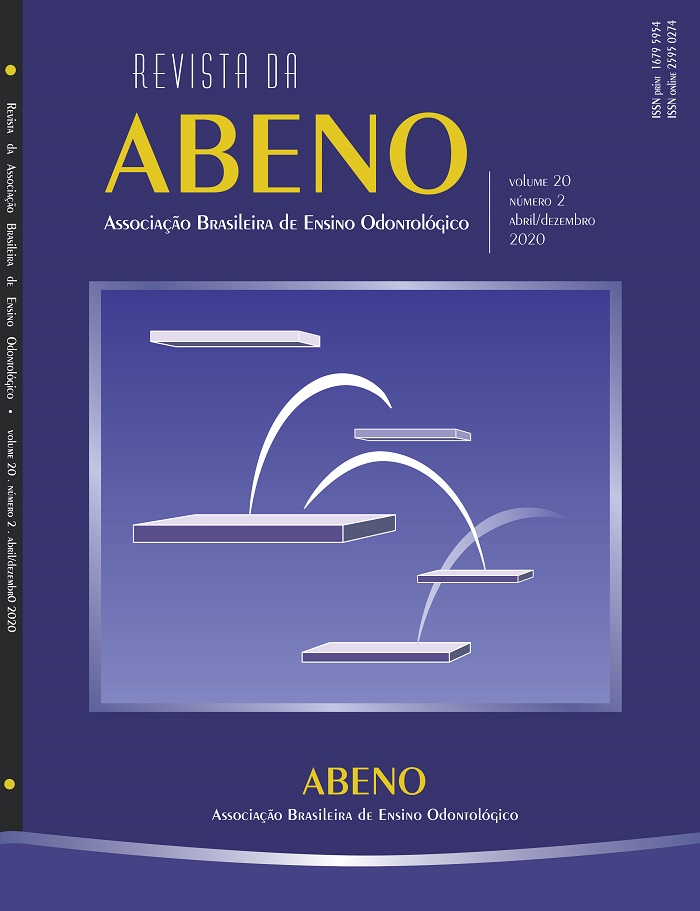Use of scenarios with people with disabilities and their families in dental education
DOI:
https://doi.org/10.30979/rev.abeno.v20i2.921Keywords:
Education. Dentistry. Disabled Persons.Abstract
The aim of this study was to use a scenario involving people with disabilities, their families, and dental students to assess students’ perceptions of the needs of people with disabilities. This is a qualitative cross-sectional study that included 60 dental students enrolled in the discipline of Integrated Clinical Care of Patients with Special Needs. Focus groups were formed and each group received a semi-structured questionnaire with questions about aspects of the care provided to people with disabilities and about their routine. A scenario was then used in which students interacted with people with disabilities and their families. In the last phase of the study, the groups formulated hypotheses about the care of these patients. The data collected in three time periods were grouped into categories and themes and analyzed using the Atlas Ti software. The results obtained were categorized according to the students' perception before and after the creation of the scenario. After the qualitative analysis, the data revealed that, before the creation of the scenario, the students placed themselves at the center of the discussion, arguing that attending to people with disabilities would be an opportunity to develop their skills without worrying about people with disabilities themselves. After the creation of the scenario, there seems to have been an important change in the students' perception of these people and of their families and the words ‘respect’ and ‘empathy’ appeared frequently in the texts produced by the students. Bringing students closer to the reality experienced by people with disabilities and their families seems to be an alternative to educate dental students.Downloads
References
(1) Ministério da Saúde. Atenção à saúde da pessoa com deficiência no sistema único de saúde - SUS. 2009;(1):33.
(2) Censo Demográfico 2010. Características da população e dos domicílios: resultados do universo. Rio de Janeiro: IBGE, 2011. 270 p. [Acesso em 30 de julho de 2019]. Disponível em: https://biblioteca.ibge.gov.br/visualizacao/p eriodicos/94/cd_2010_religiao_deficiencia.pdf.
(3) Shin CJ, Saeed S. Toothbrushing barriers for people with developmental disabilities: a pilot study. Spec Care Dent. 2013;33(6):269-74.
(4) Olowo-Ofayoku A, John Moxham B. Comparisons between the attitudes of medical and dental students toward the clinical importance of gross anatomy and physiology. Clin Anat. 2014;27(7):976-87.
(5) Donate-Bartfield E, Lobb WK, Roucka TM. Teaching culturally sensitive care to dental students: a multidisciplinary approach. J Dent Educ. 2014;78(3):454-64.
(6) Tubert-Jeannin S, Jourdan D. Renovating dental education: a public health issue. Eur J Dent Educ. 2018;22(3):e644-e47.
(7) Lown Ba, Sasson JP, Hinrichs P. Patients as partners in radiology education. an innovative approach to teaching and assessing patient-centered communication. Acad Radiol. 2008;15(4):425-32.
(8) Postma TC, White JG. Developing students’ clinical reasoning skills: correlates of perceived relevance of two teaching and learning approaches. Eur J Dent Educ. 2017;21(1):52-57.
(9) Botelho M, Gao X, Bhuyan SY. An analysis of clinical transition stresses experienced by dental students: a qualitative methods approach. Eur J Dent Educ. 2018;22 (3):e564-e72.
(10) Edwards PC, Graham J, Oling R, Frantz KE. The patient educator presentation in dental education: reinforcing the importance of learning about rare conditions. J Dent Educ. 2016;80(5):533-41.
(11) Bark MM, Posanski M, Oliveira KV, Brancher JA, Kriger L, Gabardo MCL. Alterity and empathy : essential virtues for the training of the dentist. Rev ABENO. 2018;18:104-13.
Downloads
Published
How to Cite
Issue
Section
License
Autores que publicam nesta revista concordam com os seguintes termos:
a) Autores mantém os direitos autorais e concedem à revista o direito de primeira publicação, com o trabalho simultaneamente licenciado sob a Licença Creative Commons Attribution que permite o compartilhamento do trabalho com reconhecimento da autoria e publicação inicial nesta revista.
b) Autores têm autorização para assumir contratos adicionais separadamente, para distribuição não-exclusiva da versão do trabalho publicada nesta revista (ex.: publicar em repositório institucional ou como capítulo de livro), com reconhecimento de autoria e publicação inicial nesta revista.
c) Autores têm permissão e são estimulados a publicar e distribuir seu trabalho online (ex.: em repositórios institucionais ou na sua página pessoal) a qualquer ponto antes ou durante o processo editorial, já que isso pode gerar alterações produtivas, bem como aumentar o impacto e a citação do trabalho publicado (Veja O Efeito do Acesso Livre).






